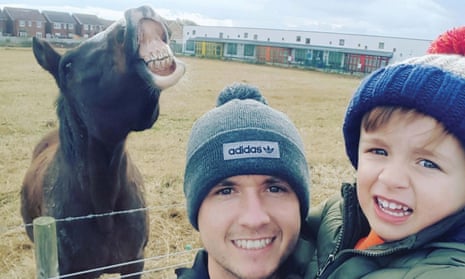Sometimes, in the small hours, terrible visions haunt you. Loved ones, upset. Abandoned children. Satanic flashes. Long-suppressed scenes from especially frightening films. And now, to add to the portfolio of nighttime horrors, we have Betty the photobombing horse from Prestatyn, north Wales.
For those unfamiliar with Betty, she is a muddy-coloured mare who became famous earlier this week after unwittingly helping secure a young family a £2,000 holiday. A father and his toddler son took a selfie outside her paddock; she cameos in the corner of the screen, lips parted, head slightly askew. The dad entered the photo in Thomson’s Made Me Smile competition; on hearing of his win, Betty’s owner demanded compensation. (Betty herself has yet to comment.)
“It is our horse that has really won them the holiday,” said Nicola Mitchell, who bought Betty three years ago. “I didn’t even know that this competition was on. If I had known about it we would have entered it ourselves and could have won as Betty is always sticking out her tongue.”
The winning snap, in fact, does not showcase Betty’s tongue. It is presumably restrained behind her tombstone teeth, which are what your gaze first alights upon when you look at the photo, with their distinctive 60-a-day tint and striking red stripe running down the middle. You then notice her whopping gums, wet and pink and mottled at the top, her curled lips, her splayed nostril, the glint in her squinting eye and her muscled, hairy neck, straining at the barbed wire.
You can nearly hear the whinny. You can practically picture the carnage that would probably have ensued had they hung about a minute or two longer, had the fence not held and had the father enabled video mode. I don’t know what kinds of smiles the Thomson reps are usually met with, but celebrating Betty’s horrific grimace as a classic of the form makes me grateful I don’t work for the holiday company.
It’s not just Thomson, of course. If an animal flashes its gnashers at us, we generally presume it is in on the joke. Our joke, that is – one about smartphone photography and viral memes and shareable, snackable content. But the squid or squirrel getting in the way of the lens probably isn’t so savvy. Betty certainly wasn’t thinking about her standing on social media. I’ve barely fed a horse carrots, let alone sat on one, but even I can see in her face a combination of anger, hunger and confusion, rather than the larky desire to promote some lols on Instagram.
In the past, it was only children who were encouraged to anthropomorphise, to read benevolence into even the fiercest of beasties. Teddies were tolerated until your early teens; then – ran the logic – you were meant to grow up and realise bedding down with a bear rarely results in a great night’s sleep.
Now, that second stage seems to be getting forgotten. Scroll through animal photobombs online – it’s hard not to – and it’s rarely a child that is being gawped at by a goat. It’s their parents, or simply people without the figleaf of a child. There are still limits: having plush puppies clustered round your work computer may dint your professional reputation, but using that computer to watch kittens frolic in a sink is practically compulsory.
Decades of being raised on cartoons have bred a generation of people who communicate through emojis and who want playthings, not pets; who infer cuteness into even the angriest nag just to match our mood. The movement to convert animals into accessories for adults has gathered such pace that we don’t just neuter them, we customise them – non-moulting fur, the right density of spots – to our individual taste.
Businesses cater accordingly. In wetland centres around the UK, twitchers are cross about the invasion of giant Lego birds to help lure in families. The purpose of such centres, they protest, should be to examine the real thing, in something approaching its natural environment, rather than to have your photo taken clambering over a big, grinning plastic version.
And after decades of dubious press, zoos must be thrilled by the advent of the selfie stick. The devices have enabled them to be organically relaunched as enormous photobooths, perfect for capturing animal partycrashing. Stick around long enough at an aquarium and a fish is bound to pull a face in the background.
What drives all this is not simply infantilism – it is also individualism. As the planet warms, so human focus seems to intensify on our own fate, rather than those of other creatures. And as we further abandon a sense of responsibility, so we become more self-interested, more species-ist, less bothered about fitting into an ecosystem. Animals can either get on board with helping us survive us or get lost.
Problem is, they won’t. Fifty years from now, if we get to a stage of sufficient chaos that we must fend for ourselves among the wildebeests, our fight-or-flight reflexes will need to be pretty keen. Then, there will be no time for photos with animals we hope are friendly. Betty will have her day. And she will be ready for her closeup.

